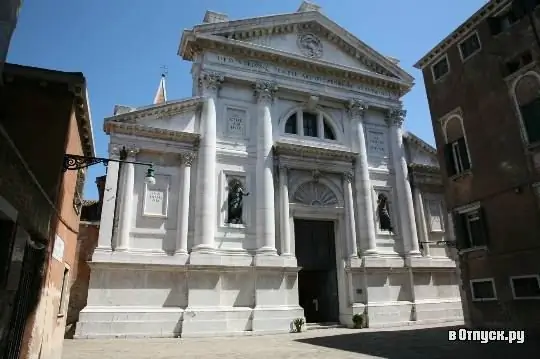
Description of the attraction
San Francesco della Vigna is a Roman Catholic church in the Castello quarter of Venice. Together with the church of Santa Maria Gloriosa dei Frari, this temple is one of the two Franciscan churches in Venice. Once upon a time, a vineyard - vigna was located on this site, and in 1253 the construction of a monastery began here. There was already a tiny chapel that marked the place where, according to legend, an angel appeared to the Apostle Mark, the patron saint of Venice.
The first Gothic church on this site was built by the architect Marino da Pisa and had three naves. By the 16th century, the building of the temple was in a depressing state and required serious repairs. At the same time, a reform was carried out that destroyed the Minorite Franciscan order, and the Doge Andrea Gritti, who ruled in Venice, whose family palace stood not far from the church, ordered the reconstruction of the building. It was this doge who in 1534 laid the foundation stone for the new church.
The San Francesco della Vigna project was designed by the architect Jacopo Sansovino - he wanted to build a new church in the Renaissance style. One of the Franciscan monks, Fra Zorzi, also took part in the project, who insisted that the central nave of the temple be 9 sideways wide and 27 sideways long, and each of the three side chapels - three sideways wide (one side is equal to 76.2 cm). The chapels were sold for 250-300 ducats to aristocratic sponsors, which made it possible to raise the necessary funds for the construction. In exchange, the aristocrats were promised that the chapels would be decorated with their family crests, and their bodies would be buried inside. For the right to be buried in the altar of the temple in front of the main throne, Doge Andrea Gritti paid 1,000 ducats. In 1542, Vettor Grimani and his brother Cardinal Marino undertook the construction of the facade of the church, but it was finally completed only in 1562 with the participation of the great Andrea Palladio.
The interior decoration of San Francesco della Vigna, with its Doric columns of pale Istrian marble, is distinguished by the simplicity and severity characteristic of the Franciscans. Choirs are located behind the altar. The church is decorated with a plaster sculpture of Saint Louis of Toulouse and a Gothic image of the Blessed Virgin Mary from the 15th century. The Grimani Chapel (first in the left side aisle) is decorated with paintings by Battista Franco. There you can also see the altarpiece of Federico Zuccari. The third chapel on the right contains paintings by Francesco Fontebasso, and the third chapel on the left, with a dome, is decorated with frescoes by Tiepolo and a sculpture by Andrea Cominelli. She bears the name of Saint Gerardo Sagredo. There are also the sarcophagi of Doge Niccolo Sagredo and Alvise Sagredo by Giovanni Guy. The walls are painted with frescoes by Tiepolo depicting the four Evangelists.






